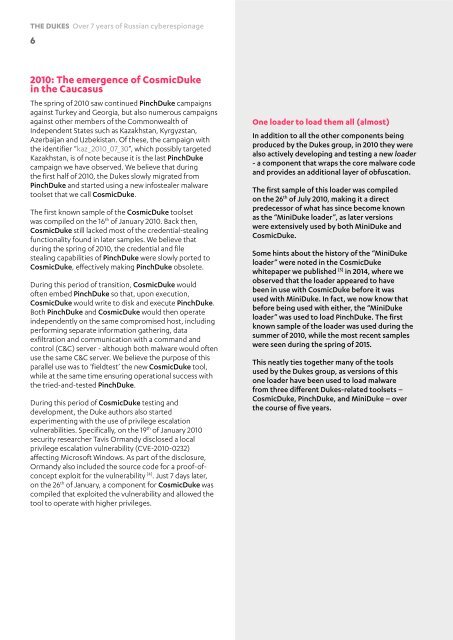THE DUKES
w75flE
w75flE
You also want an ePaper? Increase the reach of your titles
YUMPU automatically turns print PDFs into web optimized ePapers that Google loves.
<strong>THE</strong> <strong>DUKES</strong> Over 7 years of Russian cyberespionage<br />
6<br />
2010: The emergence of CosmicDuke<br />
in the Caucasus<br />
The spring of 2010 saw continued PinchDuke campaigns<br />
against Turkey and Georgia, but also numerous campaigns<br />
against other members of the Commonwealth of<br />
Independent States such as Kazakhstan, Kyrgyzstan,<br />
Azerbaijan and Uzbekistan. Of these, the campaign with<br />
the identifier “kaz_2010_07_30”, which possibly targeted<br />
Kazakhstan, is of note because it is the last PinchDuke<br />
campaign we have observed. We believe that during<br />
the first half of 2010, the Dukes slowly migrated from<br />
PinchDuke and started using a new infostealer malware<br />
toolset that we call CosmicDuke.<br />
The first known sample of the CosmicDuke toolset<br />
was compiled on the 16 th of January 2010. Back then,<br />
CosmicDuke still lacked most of the credential-stealing<br />
functionality found in later samples. We believe that<br />
during the spring of 2010, the credential and file<br />
stealing capabilities of PinchDuke were slowly ported to<br />
CosmicDuke, effectively making PinchDuke obsolete.<br />
During this period of transition, CosmicDuke would<br />
often embed PinchDuke so that, upon execution,<br />
CosmicDuke would write to disk and execute PinchDuke.<br />
Both PinchDuke and CosmicDuke would then operate<br />
independently on the same compromised host, including<br />
performing separate information gathering, data<br />
exfiltration and communication with a command and<br />
control (C&C) server - although both malware would often<br />
use the same C&C server. We believe the purpose of this<br />
parallel use was to ‘fieldtest’ the new CosmicDuke tool,<br />
while at the same time ensuring operational success with<br />
the tried-and-tested PinchDuke.<br />
During this period of CosmicDuke testing and<br />
development, the Duke authors also started<br />
experimenting with the use of privilege escalation<br />
vulnerabilities. Specifically, on the 19 th of January 2010<br />
security researcher Tavis Ormandy disclosed a local<br />
privilege escalation vulnerability (CVE-2010-0232)<br />
affecting Microsoft Windows. As part of the disclosure,<br />
Ormandy also included the source code for a proof-ofconcept<br />
exploit for the vulnerability [4] . Just 7 days later,<br />
on the 26 th of January, a component for CosmicDuke was<br />
compiled that exploited the vulnerability and allowed the<br />
tool to operate with higher privileges.<br />
One loader to load them all (almost)<br />
In addition to all the other components being<br />
produced by the Dukes group, in 2010 they were<br />
also actively developing and testing a new loader<br />
- a component that wraps the core malware code<br />
and provides an additional layer of obfuscation.<br />
The first sample of this loader was compiled<br />
on the 26 th of July 2010, making it a direct<br />
predecessor of what has since become known<br />
as the “MiniDuke loader”, as later versions<br />
were extensively used by both MiniDuke and<br />
CosmicDuke.<br />
Some hints about the history of the “MiniDuke<br />
loader” were noted in the CosmicDuke<br />
whitepaper we published [5] in 2014, where we<br />
observed that the loader appeared to have<br />
been in use with CosmicDuke before it was<br />
used with MiniDuke. In fact, we now know that<br />
before being used with either, the “MiniDuke<br />
loader” was used to load PinchDuke. The first<br />
known sample of the loader was used during the<br />
summer of 2010, while the most recent samples<br />
were seen during the spring of 2015.<br />
This neatly ties together many of the tools<br />
used by the Dukes group, as versions of this<br />
one loader have been used to load malware<br />
from three different Dukes-related toolsets –<br />
CosmicDuke, PinchDuke, and MiniDuke – over<br />
the course of five years.


